2022 is a good year for stargazing here on Hawaiʻi with 2 total lunar eclipses and 2 (out of 3) of the big meteor showers happening during favorable viewing conditions.
These are the most important 2022 stargazing dates for Hawaiʻi:
If you are in the mood of planning ahead you should reserve the following dates in your calendar for stargazing:
Table of contents
- January 3: Quadrantids meteor shower
- April 22: Lyrids meteor shower
- May 5: Eta Aquariids meteor shower
- May 15: Total lunar eclipse
- May 18-31: lahaina noon (1/2)
- June 20: Summer solstice
- July 11-25: lahaina noon (2/2)
- August 12: Perseids meteor shower
- October 21: Orionids meteor shower
- November 7 to 8: Total Lunar Eclipse
- December 14: Geminids meteor shower
- December 21: Winter solstice
Table of Contents
- January 3: Quadrantids meteor shower
- April 22: Lyrids meteor shower
- May 5: Eta Aquariids meteor shower
- May 15: Total lunar eclipse
- May 18-31: lahaina noon (1/2)
- June 20: Summer solstice
- July 11-25: lahaina noon (2/2)
- August 12: Perseids meteor shower
- October 21: Orionids meteor shower
- November 7 to 8: Total Lunar Eclipse
- December 14: Geminids meteor shower
- December 21: Winter solstice
This stargazing calendar will help you plan your nights to make the best of the biggest celestial events of 2022. To make the most of your time we recommend that you go to one of our favorite stargazing spots and read our Meteor shower guide, which is filled to the brim with viewing tips and background information about shooting stars.
Newsletter reminders for stargazing events
If you subscribe to our newsletter we will send you a monthly overview that includes upcoming local events, volcano updates, new and noteworthy places and restaurants and other venues, and all the important astronomy events.
Have a look here to see what you can expect from our newsletter or sign up directly below.
Also, don’t forget to have a look at our guide: stargazing on the Big Island. The MaunaKea volcano hosts some of the best telescopes of the world, and a visit to these telescopes is a must if you are into stargazing!
Stargazing events for Hawaiʻi (2022)
Stargazing highlights for Hawaii in 2022 are hands down the January 3 Quadrantids meteor shower and the November 7 + 8 total lunar eclipse.
January 3rd: Quadrantids Meteor Shower #
The Quadrantids are one of the 3 biggest meteor showers of the year, and 2022 is a GREAT year to see its shooting stars.
This meteor shower is expected to peak at January 3rd at around 10:40 AM HST (Hawaiian Standard Time). We have to wait a bit until about an hour after sunset to be able to start shooting stars, but luckily the new moon on January 2nd makes sure that the skies are as dark as they can be! The best time to see shooting stars from the Quadrantids is during midnight and an hour before dawn on January 2nd and 3rd.
This is hands-down the best meteor shower to watch in 2022.
Quadrantids trivia!
The Quadrantids meteor shower is named after an abandoned constellation named Quadrans Muralis. This constellation was invented in 1795 by the astronomer Joseph Jérôme de Lalande to honor the wall-mounted instrument which he used for measuring star positions (a “Quadrant” is an improved astrolabe, and is used to measure angles up to 90°; “muralis” is Latin for wall). The constellation never really “caught on” and its use was quickly abandoned. However, it now is the most well known out-of-date constellation because it gives its name to the Quadrantids meteor shower.
The Quadrantids are special among meteor showers because this shower has a very ‘sharp’ peak intensity. The shower is most active for only a short amount of time (the meteor rates exceed one-half of their highest value for only about 8 hours). This means that the space debris that causes this shower has been left ‘on location’ pretty recently, within the last ±500 years.
April 22: Lyrids Meteor Shower#
The lyrids in 2022 reach their maximum just before the last quarter Moon which means that the hours with a high radiant elevation are moonlit.
This year peak activity of the meteor shower is expected be on April 22nd around 9 AM HST. The moon sets at 01:26 AM that morning, so the second half of the night up to the start of twilight at 5 AM is good for stargazing.
Fun Facts about the Lyrids meteor shower
The shooting stars of the Lyrids are small parts of space-debris left behind by the comet Thatcher (C/1861 G1). They are (arguably) the first documented meteor shower with reports going back possibly up to 2600 years (687 BC, two years after King Sennacherib of Assyria sacked Babylon).
most years you can see between 10 and 20 shooting stars/hour at peak intensity, but there have been years where a true meteor shower took place, and peak rates of 90/hour were reported. The last time this happened was in 1982, but there is also a very interesting report from a newspaper in Richmond, Virginia on April 23rd, 1803. This newspaper described the shower as follows:
…Shooting stars. This electrical phenomenon was observed on Wednesday morning last at Richmond and its vicinity, in a manner that alarmed many, and astonished every person that beheld it.
From one until three in the morning, those starry meteors seemed to fall from every point in the heavens, in such numbers as to resemble a shower of sky rockets…
These outburst are quite rare, but the point we want to make is that you never know what to expect with the Lyrids.
May 5: Eta Aquariids Meteor Shower#
The η-Aquariids meteor shower peaks just before midnight May 5th around 10PM HST. The moon sets that night 1.5 hours later at 11:20, which makes the period between midnight and an hour before sunrise great for stargazing.
This meteor shower has a reasonable ZHR (zenith hourly rate, or the amount of shooting stars estimated to be visible during the peak activity under ideal circumstances) and has broad peak activity. Shooting stars belonging to this shower can be observed between April 19th up to May 28th.
Eta Aquariids Trivia
Did you know that the Eta Aquariids have a sister meteor shower? The Eta Aquariids meteor shower happens when earth passes through the space-debris left by Halley’s Comet. Because Halley’s comet and our planet orbit the sun in the same plane, there is another point in space where earth crosses the debris from this comet. When this happens, we see the meteor shower the Orionids (and not the Delta Aquariids as people often think).
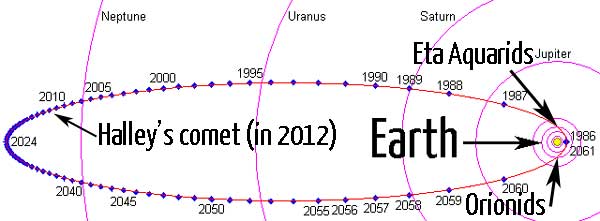
Current position and orbit of Halley’s comet around our solar system. Every blue dot shows you where the comet is in that year. You can see the comet passes twice (in 1986 and 2061) close to earth, leaving enough space-debris to cause two meteor showers: the Eta Aquariids (early May) and the Orionids (late October). Image adapted from source.
Halley’s Comet is the most famous short period comet of our solar system, and returns every 75 or 76 years. The last time it flew by was in 1986, the next time will be in 2061. Right now Halley’s Comet is deep in the outer solar system (beyond Neptune!) but you will still be able to see little particles of it burn up into earths atmosphere twice a year during the Eta Aquariids and the Orionids meteor showers.
Each time it swings by the sun, solar heat vaporizes about 6(!) meters of ice and rock from the nucleus. The debris particles, about the size of sand grains, spread along the comet’s orbit, filling it with tiny meteoroids.
May 15: (almost) Total lunar eclipse #
On the early evening of May 15, 2022, Hawaiʻi will be treated to an almost total lunar eclipse. The eclipse reaches totality at 18:50, just after the moon rises at 18:47, and the eclipse lasts until 18:53. This eclipse cannot be called a “total” one when seen from Hilo because it will not have risen completely above the horizon during the moment of maximum eclipse.
Fun fact: the Big Island and the most eastern tip of Maui are the only places from where you get to see the totally eclipsed moon. All other islands have to make do with a partial eclipse (see the image below adapted from this eclipse map).
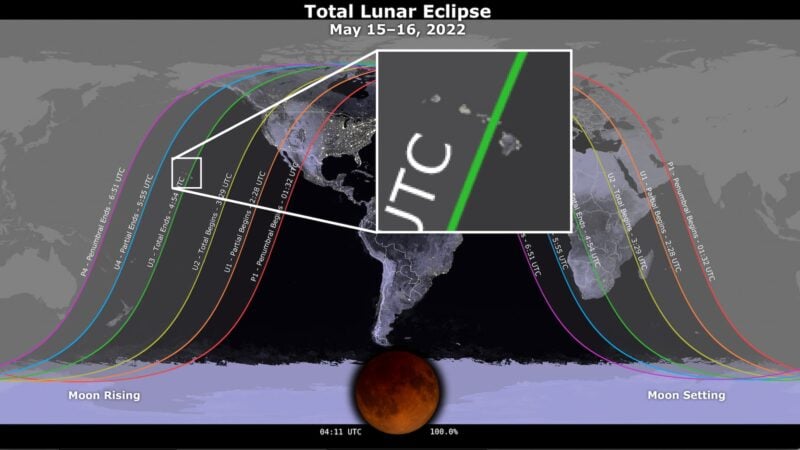
A map showing where the May 15-16, 2022 lunar eclipse is visible with an inset showing the Hawaiian islands. The green line denotes the edge where the eclipse is still total. Image adapted from this NASA eclipse visibility map.
Because the eclipse happens very close to the moonrise we recommend that you find a high spot with views facing east for the best views. More details on this lunar eclipse (including a video preview) can be found on the time and date website.
Any place with a clear view towards the east is sufficient because of how bright and large the moon is, but why not go fancy and try out one of our favorite sunrise viewing spots?
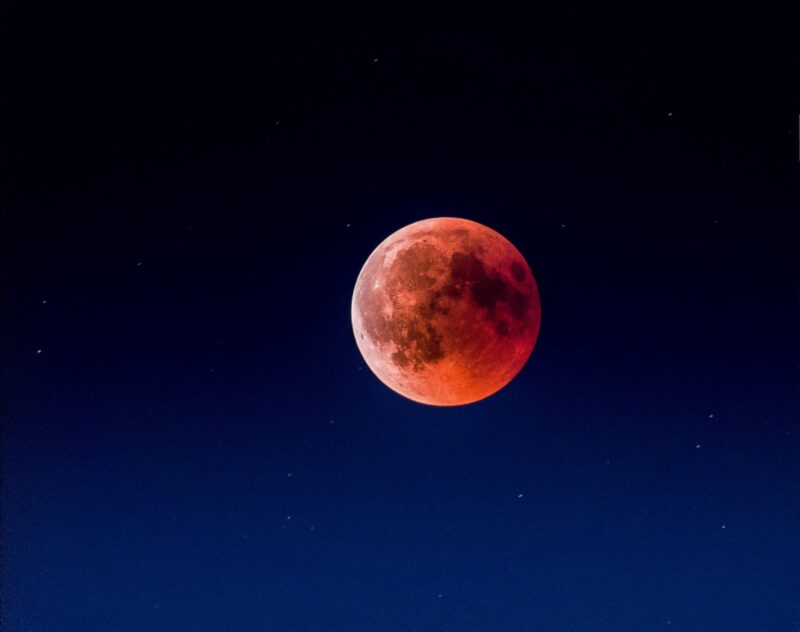
During a lunar eclipse the moon gets blood-red as it dips into earth’s shadow. Photo by Martin Adams on Unsplash
Ps: If you want to know the ‘how and why’ of lunar eclipses we recommend you read our lunar eclipse 101 guide.
Pps: The next total lunar eclipse visible from Hawaii will take place on the night of November 7 to 8, 2022.
May 18-31: lāhainā noon#
Hawai’i is the only tropical state in the USA. This comes with certain perks such as tropical weather and the two times each year when you don’t cast any shadow!
Lāhainā noon is a recent (1990) term, introduced to give a name to the time of day on which the sun is directly overhead. “Lā haina” means “cruel sun” in the Hawaiian language. Lāhainā noon is known on the rest of the planet as being at the ‘sub-solar point’, i.e. that point where the sun is standing directly above you and thus you don’t cast any shadow. This is elegantly explained in the following video by vsause (skip to 03:17):
But don’t worry, the sun isn’t that cruel on Hawaii! Unless you are on the hot lava plains without enough water to drink, that is. Better yet, lāhainā moon is a very cool photo opportunity and a time to stop and think about how exactly our planet revolves around the sun. Because of this, lāhainā noon occurs on slightly different times for different places.
On the Hawaiian islands the 2022 lāhainā noon will happen at the following times for these cities:
- Honolulu (O‘ahu): 12:28 PM (May 26+27)
- Kahului (Maui): 12:22 PM (May 24)
- Līhuʻe (Kauai): 12:35 PM (May 31)
- Hilo: 12:16 PM (May 18)
- Kona: 12:20 PM (May 18)
June 20th: Summer Solstice and Midsummer Night#
Happy Summer Solstice, today is the first day of astronomical summer! The 2022 summer solstice takes place in Hawaiʻi at June 20th at 23:13 am HST (calculated for Hilo).
The Hawaiian term for summer solstice is “Ka māuikiʻikiʻi o ke kauwela” [source].
Midsummer night is the shortest night of the year, and you could try to make your midsummer night a special one. What better excuse is there for a celebration? Many cultures have festivities linked to the summer solstice, so what about organizing your own midsummer night party or pau hana’s?
July 11-25: lāhainā noon (2/2) #
Lāhainā noon is the moment when the sun is standing directly above you. This means that the only shadow you cast is directly below you, and that tall vertical objects. such as for example phone poles and beer bottles, won’t cast a shadow at all!
You can read a more elaborate explanation about the lāhainā noon at the may listing of this event(1/2).
On the Hawaiian islands, the 2022 lāhainā noon will happen at the following times for these cities:
- Honolulu (O‘ahu): 12:37 PM (July 15 + 16)
- Kahului (Maui): 12:32 PM (July 18)
- Līhuʻe (Kauai): 12:43 (July 11)
- Hilo: 12:26 PM (July 24)
- Kona: 12:30 PM (July 24+25)
August 12: Perseids Meteor Shower#
Full Moon on August 12 will badly affect visibility of shooting stars for the 2022 Persids meteor shower.
The Perseids have a broad peak which on Hawaii will fall on the late afternoon of August 12th. However, full moon falls this year on August 11th, and the moon will outshine all but the gew brightest shooting stars this year.
Perseids Trivia
The Perseids happen each year as earth passes by a trail of dust, gas and ice left behind by the comet Swift-Tuttle. This comet was first documented in 1862, and returns to the sun every 130 years (the next time it will be visible from the earth will be in 2122). The earliest recorded sighting of Perseids dates back to 36 AD, when mention was made of “more than 100 meteors” in Chinese annals (source).
The Perseids are also referred to as the “tears of St. Lawrence”, because the festival of this saint is very close (August 10th) to the peak of the Perseids. The story of Laurentius (Lawrence), a Christian deacon, is the following: Laurentius was martyred by the Romans in 258 AD on an iron outdoor stove. It was in the midst of this torture that Laurentius cried out: (source)
I am already roasted on one side and, if thou wouldst have me well cooked, it is time to turn me on the other.
In honor of this history, one very appropriate midnight-snack to take out is the typically Hawaiian “Huli-Huli” (= turn-turn in Hawaiian) Chicken.
In Polynesia, Perseus was not commonly recognized as a separate constellation; the only people that named it were the people of the Society Islands, who called it Faa-iti, meaning “Little Valley” (more).
October 21: Orionids Meteor Shower #
Some moonlight interference means that stargazers will need to restrict their meteor shower watching between ~midnight and moonrise (at 02:59 on the early morning of the 21st).
How to best see shooting stars from the Orionids meteor shower
Shooting stars from the Orionids meteor shower are easy to find: just find the Orion constellation, look in its general direction, and relax your gaze.
To find the Orion constellation you should look for the three bright stars in a line that make up the belt of Orion. These stars rise over the Eastern horizon just after sunset and will keep rising towards the east-south-east until they are almost overhead at dawn [how-to guide].
You can read more viewing tips in our meteor shower guide.
Orionids Trivia
The Orionids are the brighter sibling of the Eta Aquarids meteor shower (early May). Both showers are caused by debris left by Halley’s comet.

Current position and orbit of Halley’s comet around our solar system. Every blue dot shows you where the comet is in that year. You can see the comet passes twice (in 1986 and 2061) close to earth, leaving enough space-debris to cause two meteor showers: the Eta Aquariids (early May) and the Orionids (late October). Image adapted from source.
Halley’s Comet is the most famous short period comet of our solar system, and returns every 75 or 76 years. The last time it flew by was in 1986, the next time will be in 2061. Right now Halley’s Comet is deep in the outer solar system (beyond Neptune!) but you will still be able to see little particles of it burn up into earths atmosphere twice a year during the Eta Aquarids and the Orionids meteor showers.
Each time it swings by the sun, solar heat vaporizes about 6(!) meters of ice and rock from the comet. The debris particles, about the size of sand grains, spread along the comet’s orbit, filling it with tiny meteoroids.
November 7+8: Total lunar eclipse #
This is the best lunar eclipse to observe from the Hawaiian islands in 2022. The next total lunar eclipse will only happen 2.5 years from this one, on March 14, 2025, so make sure to take some time to appreciate this one if lunar eclipses peak your interest.
The eclipse as seen from Hilo will start on the evening of November 7th, and reaches totality at 00:16 AM on November 8th. The total eclipse will last 1 hour and 25 minutes, up to 01:41 AM. You can find more information on the timing, as well as a simulation of the progression of the eclipse from Honolulu, on the Time and Date website.
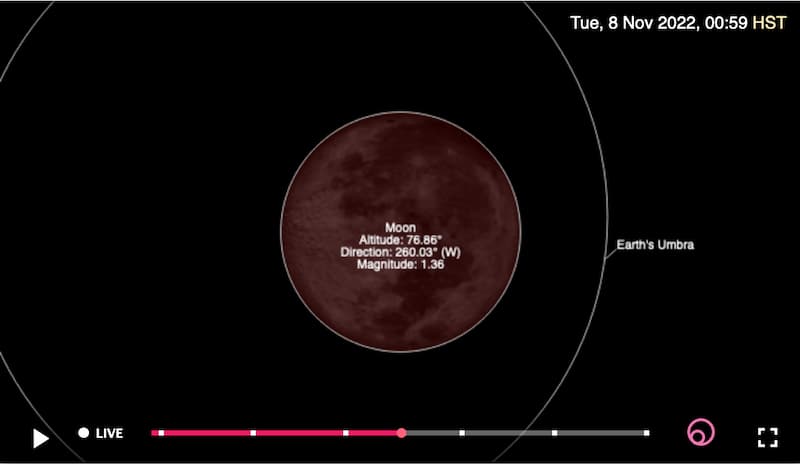
Simulation of what the lunar eclipse will look like from Hilo at the moment of maximum eclipse. Credit: the Time and date website.
If you want to know the ‘how and why’ of lunar eclipses we recommend you read our lunar eclipse 101 guide.
December 14: Geminids Meteor Shower#
2022 is an okay year to watch the Geminids meteor shower.
The Geminids are the best and most reliable of the major annual showers, and is predicted to reach its peak activity on December 14th just after midnight (1 AM HST). This is only 6 days after the full moon, so some coordination is needed for a successful night of stargazing.
The best window to see the Geminids is on the evening of December 13th and 14th between 1 hour after twilight and an hour before moonrise. This means that your best window for the evening of December 13th is between 7:34PM and 9:40 PM, and for the evening of December 14th between 7:35PM and 10:30PM.
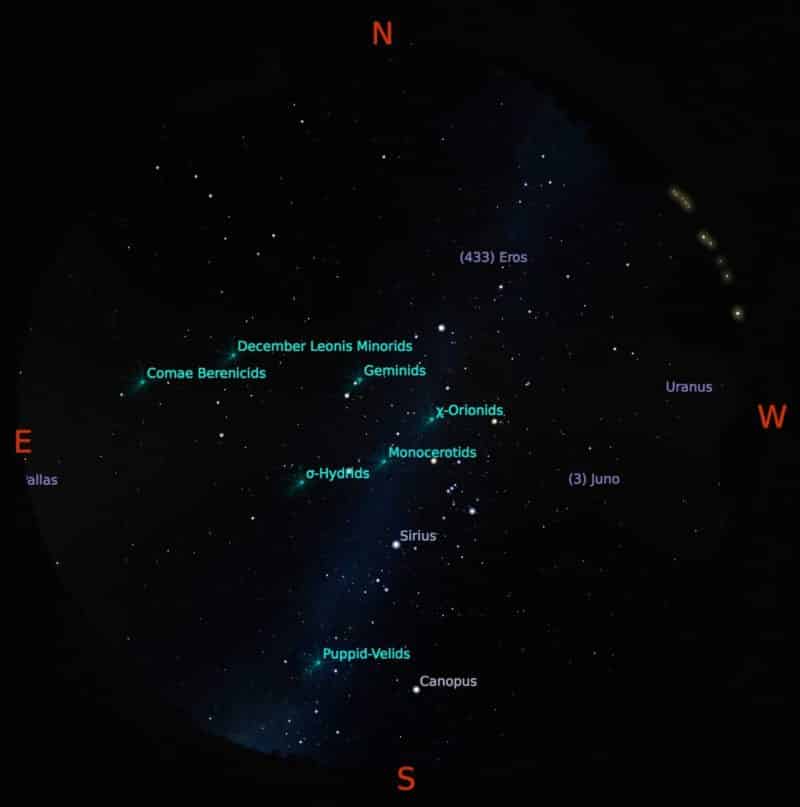
Skymap showing the Hilo nightsky at December 14th at 01:30 am made using the free planetarium software Stellarium
December 21: Winter solstice#
This year the winter solstice will take place on December 21st just before midnight (at 11:48 PM HST) Hawaiian time (calculated for Hilo).
The winter solstice represents the shortest day and thus the longest night on the Northern hemisphere. A solstice is an event that occurs twice each year as the Sun reaches its highest or lowest point relative to the celestial equator on the celestial sphere. You can find a good explanation of exactly what a solstice is here.
The Hawaiian term for winter solstice is “Ka māuikiʻikiʻi o ka hoʻoilo” [source].
Resources used to compile the 2022 stargazing calendar
All dates were selected from the International Meteor Organization Shower Calendar for 2022 (PDF). Moon rise and moon set times were retrieved from the timeanddate lunar calendar.